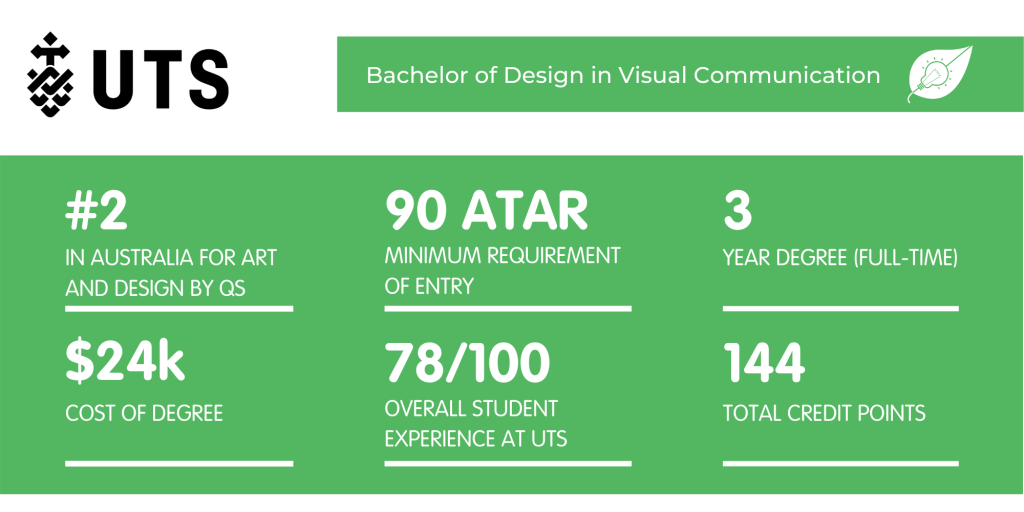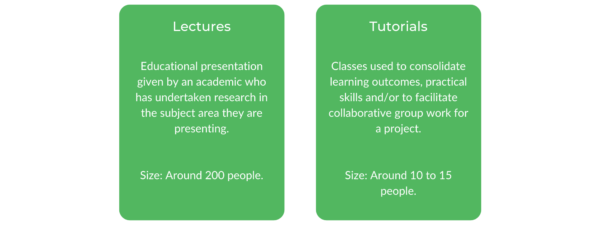If you have an interest in design and you’re thinking about taking the leap and studying a Bachelor of Design in Visual Communication at UTS, this guide has everything you could ever need to know if this degree is right for you!
So if you’re interested in learning about the different subjects, course structure, university culture and more, then this is for you, so get reading!
What is a Bachelor of Design in Visual Communication at UTS?
Core Units for this Degree
How to Get into Visual Communication at UTS
What’s the Teaching Format?
What’s the Faculty and Culture Like?
What is a Bachelor of Design in Visual Communication at UTS?
A Bachelor of Design in Visual Communication is a wide stretching and in-depth degree that teaches students all aspects of the visual world. This equips students with design skills that can cater towards a world of changing technology, media and culture.
This degree is very practical and industry focussed, with a strong emphasis on giving students tangible skills and experience that lead them towards employment and other opportunities.
Did you know that UTS is one of the top Design schools in Australia? Find out more here!
Who should study a Bachelor of Design in Visual Communication at UTS?
This is a great degree for someone who has a flair for, or interest in design, but doesn’t necessarily already want to specialise in something like animation or graphic design. Furthermore, this is a great course for someone who has creative flair and wants to learn not just the functions of design, but also find creative and innovative ways to visually communicate.
If you want to learn about all aspects of visual communication messages as you work towards a career in design, this degree is perfect for you!
Honours
To qualify for Honours you will need at least a WAM (weight average mark) of 72.5 for a guaranteed offer, or a WAM of 65 to be able to submit an application. Completing Honours requires one additional year of study.
Career Paths
This degree is extremely versatile and can set up you up for a range of different jobs and careers, such as…
- Publication designer
- Graphic designer
- Interactive media designer
- Motion graphics designer
- Web designer
- Branding specialist
- Art director
- Illustrator
- Various roles in advertising
Core Units for this Degree
Are there any majors?
This degree does not have any majors, so everyone will graduate with the same qualification. There is rather a focus on covering multiple different types of design to give you a taste of many sectors within the design world, as well as a versatile skill set.
If particular elements of design jump out at you while studying, you can of course specialise your skills through your work/volunteer experience and further studies.
What are the Core Units?
This degree has 16 core units, which is obviously quite a lot. However, within the subjects themselves you have plenty of room for creativity and expressing yourself, which can compensate for only having two electives in the course.
Some of the stand out subjects include:
VC Design Studio: Narrative, Form and Time
This subject is a fun one that allows you to reconsider how you conceptualise design and images in your head and encourages you to tell stories through your designs. It’s a very experimental and investigative subject and involves a few different assignments that are not only enjoyable but will likely give you something to put on your portfolio!
Design Futuring
A slightly more theoretical subject that teaches you to envision different ways design can function and exist in the future. This subject really allows you to think freely from constraints and logistics and let your imagination run a little wild.
VC Project: Socially Responsive Design
This is a third year subject that allows you to apply a range of the skills you’ve picked up so far, through completing a design project for a not-for-profit community organisation. Throughout the subject you’ll also learn more about communicating with clients and how to take a human-centred approach to your design projects.
First Year
- VC Design Studio: The Politics of Image and Text
- VC Design Theory: Critical Approaches to Visual Culture
- Researching Design Histories
- VC Design Studio: The Ethics of Image and Text
- VC Design Project: Symbols, Systems and Visual Play
- Thinking Through Design
Second Year
- VC Design Studio: Narrative, Form and Time
- VC Project: Contexts of Visual Communication
- One elective
- VC Project: Typography in Context
- VC Project: Visualising Experience
- Design Futuring
Third Year
- VC Design Studio: Design Practice
- Social Media Cultures
- VC Project: Research Through Design
- VC Design Studio: Visual Communication and Emergent Practices
- VC Project: Socially Responsive Design
- One Elective
These subjects are all outlined in further detail in the course handbook! Most of the core units are very practical and give you a broad understanding of what it means to be a designer.
Electives and Internships
The course only allows two electives, however there is a lot of room for creativity within the subjects themselves, as well as opportunities to study some subjects overseas.
You will complete an internship within the degree and the faculty will offer you a lot of support in finding an internship that is relevant, worthwhile and exciting.
How to Get into Visual Communication at UTS
The ATAR cut-off for this course is 90, however, there are always alternative pathways into UTS degrees such as internal course transfers — these are detailed here!
Are there any prerequisites?
There are no prerequisites for this course, however, it is generally recommended that you’ve taken Design and Technology and/or Visual Arts as subjects. However, even if you haven’t taken these, if you have a passion for design you’ll still be completely fine!
Are there any scholarships?
UTS has many scholarship opportunities that are awarded to students on the basis of criteria such as academic excellence, cultural diversity, financial hardship and more. The relevant scholarships for this degree are outlined on the UTS websites course page.
One particularly noteworthy scholarship is the Wai Tang and Kee Wong Diversity Opportunity Scholarship that aims to provide opportunities for women of culturally diverse backgrounds in industries that they are currently underrepresented in.
You can read more details on that here!
What’s the Teaching Format?
At UTS, degrees are studied through a semester format, meaning that there are two academic sessions per year. For this degree in particular, your classes throughout the different semesters will consist of lectures and tutorials.
Class Structure
Lectures
The lectures are generally one hour long, but always very relevant to the coursework and presented engagingly. Due to this, the lectures generally have very high attendance and most students attend all of them, which means there’s normally around 200 students in a lecture.
On average, you’ll take 3 subjects a semester which will mean 3 hours or lectures per week.
Tutorials
You will either have one or two tutorials a week depending on whether the subject is worth 6 or 12 credit points. The tutorials average around an hour, but sometimes go up to two hours, so this will generally mean around 4-8 hours of tutorials per week.
The tutors are very commonly practising designers in the industry who will work very closely with you and give you extremely practical tips. The tutorial class sizes are generally only around 10 to 15 people so you’ll be able to receive very dedicated attention from the tutor, as well as get to know your classmates very well.
Assessments
Assessments in Visual Communications are mostly extremely practical and project-based.
Most assessments will involve being given a design brief that you will interpret and understand, then design something for a mock client. This structure will mirror real world design projects which is perfect for preparing yourself for the industry, as well as building your own portfolio.
You will occasionally have to do essays and more theoretical work, especially in the ‘design studios’ subjects, however, there is definitely not overly frequent essay writing. Essentially, the assessments are generally designed with the aim of giving you very practical skills and tangible output through the forms of your various projects.
Skills you learn
More than anything, this degree will have you industry ready for whichever way you choose to use your degree. Your design thinking skills will also be applicable to and valued within other professional environments.
While you’ll pick up all the required practical skills, this degree will set you apart through its focus on creative and innovative solutions that will impress potential employers and future clients.
“I learnt to understand that design isn’t just about how things look, but that it actually has a function and is really important for communicating things. Design can influence people and make them feel things.” — Lucy
What’s the Faculty and Culture Like?
Culture
The culture could best be described as collaborative and supportive. The cohorts are tight-knit so you’ll know most of the people in your classes and unlike a lot of degrees, once you finish a group assignment with someone they won’t disappear into the shadows of the night, but rather you’ll likely see them again next semester!
Beyond this, there is also a strong energy towards the importance of having fun — most students who do this degree aren’t just getting qualifications, but are really enjoying the journey as well. The very supportive faculty will not only constantly offer their mentoring to help you grow as a student, but generally have an understanding nature towards any struggles you might have, whether that be physical or mental health, or otherwise.
In a lot of ways this degree is more intimate than your average degree, and you’ll feel more cared for and attended to, as opposed to feeling like another name on a long roll.
Societies
UTS has over 130 societies so it really comes down to how much you want to put yourself out there! Whether you want to dine with the Food Appreciation Society, perform with the Comedy, Revue and Performance Society or dive in with UTS Scuba there will likely be a society that piques your interest.
More specifically, there is the Design Society where you are sure to be able to network (or preferably party) with some like minded people.
Keen to read about the pros and cons of this degree? Check out our article here!
Tallis Boerne Marcus is studying a double degree of Law and Business at UTS, but hopes to be a writer after graduating. He’s been published for many music and travel publications such as WhatsLively, ThePartyingTraveller, Livewireau, This Weekend and more! His passions lie in hip hop music, snorkelling, comedy, big cats and travelling!






